Dental charting refers to providing a quick representation or formula to define the types of teeth along with their number. There are more than 150 methods of the dental chart, but in this, we only discuss the main tooth numbering systems.
1. Universal Tooth Numbering System by Cunningham

The universal numbering system was developed by Cunningham in 1883 and is one of the most commonly used tooth numbering and notation systems that have been adopted by the American Dental Association.
Deciduous Teeth:
- Right to Left (upper jaw): A B C D E F G H I J
- Right to Left(lower jaw): T S R Q P O N M L K
Permanent Teeth:
- Right to left (upper jaw): 1 2 3 4 5 6 7 8 9 10 11 12 13 14 15 16
- Right to left (lower jaw): 32 31 30 29 28 27 26 25 24 23 22 21 20 19 18 17
2. Zsigmondy Tooth Numbering System
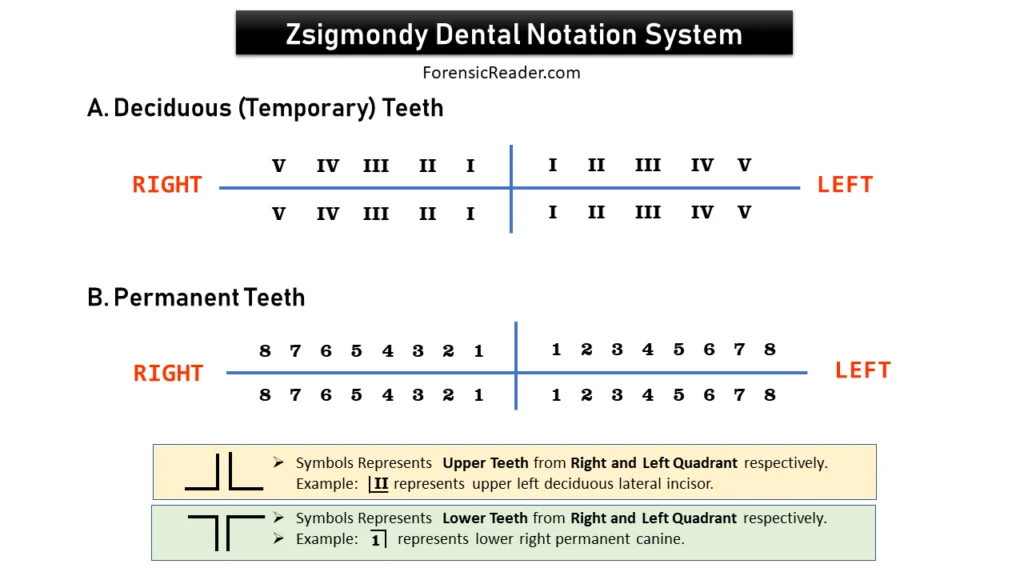
It is the earliest system that was proposed by Austrian dentist Adolph Zsigmondy in 1861. Unlike the universal system, the whole teeth structure is divided into 4 quadrants i.e. Upper right, upper left, lower right, and lower left.
Representation of Zsigmondy System for Deciduous Teeth
- Upper Right Quadrant: V IV III II I
- Upper Left Quadrant: I II III IV V
- Lower Right Quadrant: V IV III II I
- Lower Left Quadrant: I II III IV V
Representation of Zsigmondy System for Permanent Teeth
- Upper Right Quadrant: 8 7 6 5 4 3 2 1
- Upper Left Quadrant: 1 2 3 4 5 6 7 8
- Lower Right Quadrant: 8 7 6 5 4 3 2 1
- Lower Left Quadrant:1 2 3 4 5 6 7 8
3. Palmer Dental Notation System
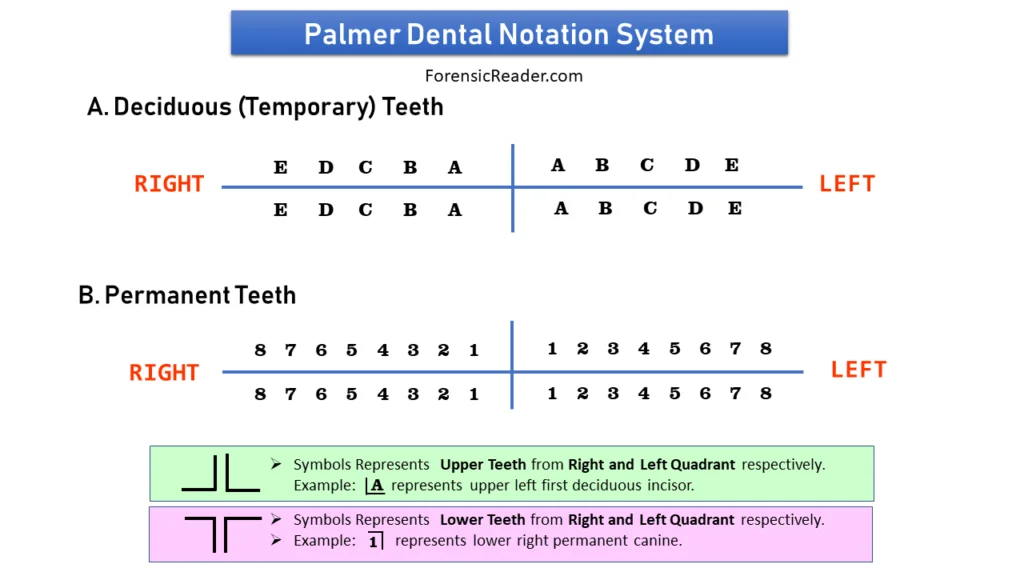
Corydon Palmer modified the Zsigmondy dental number system and replaces the Roman numerals system with simple capital alphabets. This is the reason why it is also called modified Zsigmondy Palmer notation. It was developed in 1870.
This dental nomenclature system is majorly used in the United Kingdom (UK). It failed to be adopted by non-native English-speaking countries.
Representation of Palmer Tooth Numbering System for Deciduous Teeth
- Upper Right Quadrant: E D C B A
- Upper Left Quadrant: A B C D E
- Lower Right Quadrant: E D C B A
- Lower Left Quadrant: A B C D E
Representation of Palmer Tooth Numbering System for Permanent Teeth
- Upper Right Quadrant: 8 7 6 5 4 3 2 1
- Upper Left Quadrant: 1 2 3 4 5 6 7 8
- Lower Right Quadrant: 8 7 6 5 4 3 2 1
- Lower Left Quadrant:1 2 3 4 5 6 7 8
4. FDI Dental Notation and Numbering System
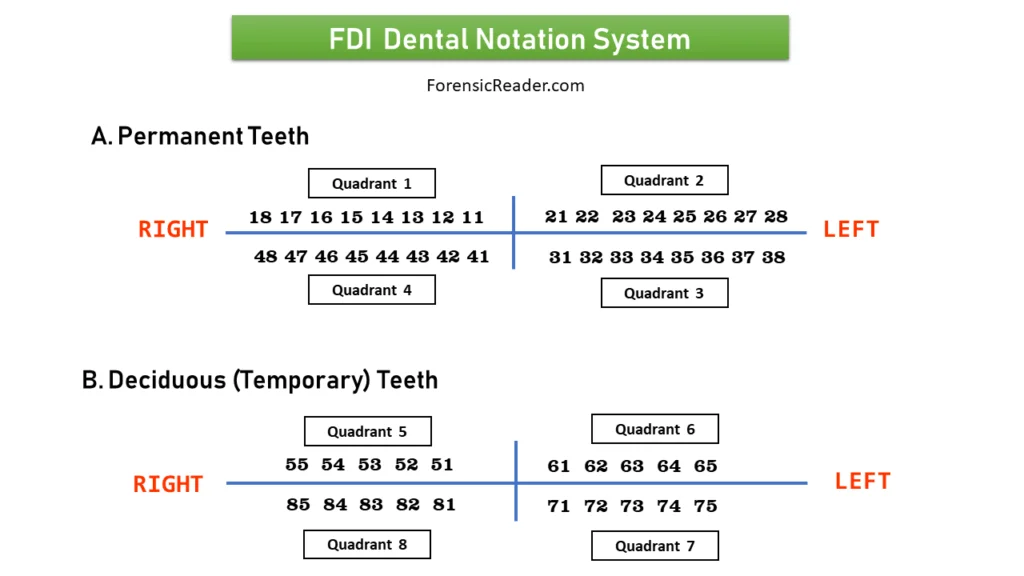
FDI system stands for Federation Dentaire Internationale. It is also called the Theilman notation system. It was developed in 1971. It is one of the common numberings for teeth that is used widely in most countries other than the US.
The values of each tooth are given by a two-digit number. The values are categorized in four-quadrant for deciduous and permanent teeth each.
Representation of FDI Nomenclature System for Permanent Teeth
- Upper Right (Quadrant 1): 18 17 16 15 14 13 12 11
- Upper Left (Quadrant 2): 21 22 23 24 25 26 27 28
- Lower Left (Quadrant 3): 31 32 33 34 35 36 37 38
- Lower Right (Quadrant 4): 48 47 46 45 44 43 42 41
Representation of FDI Nomenclature System for Deciduous Teeth
- Upper Right (Quadrant 5): 55 54 53 52 51
- Upper Left (Quadrant 6): 61 62 63 64 65
- Lower Left (Quadrant 7): 71 72 73 74 75
- Lower Right (Quadrant 8): 85 84 83 82 81
5. Navy Dental Notation System (Modified of Universal)

The Navy Dental charting system is nearly the same as Universal Cunningham notation except the numbering for the lower jaw starts with right and ends at left (like the upper jaw).
Representation of Navy Charting System for Deciduous Teeth
- Upper Jaw Teeth (right to left): A B C D E F G H I J
- Lower Jaw Teeth (right to left): K L M N O P Q R S T
Representation of Navy Charting System for Permanent Teeth
- Upper Jaw Teeth (right to left): 1 2 3 4 5 6 7 8 9 10 11 12 13 14 15 16
- Lower Jaw Teeth (right to left): 17 18 19 20 21 22 23 24 25 26 27 28 29 30 31 32
6. Modified FDI Dental Notation Charting
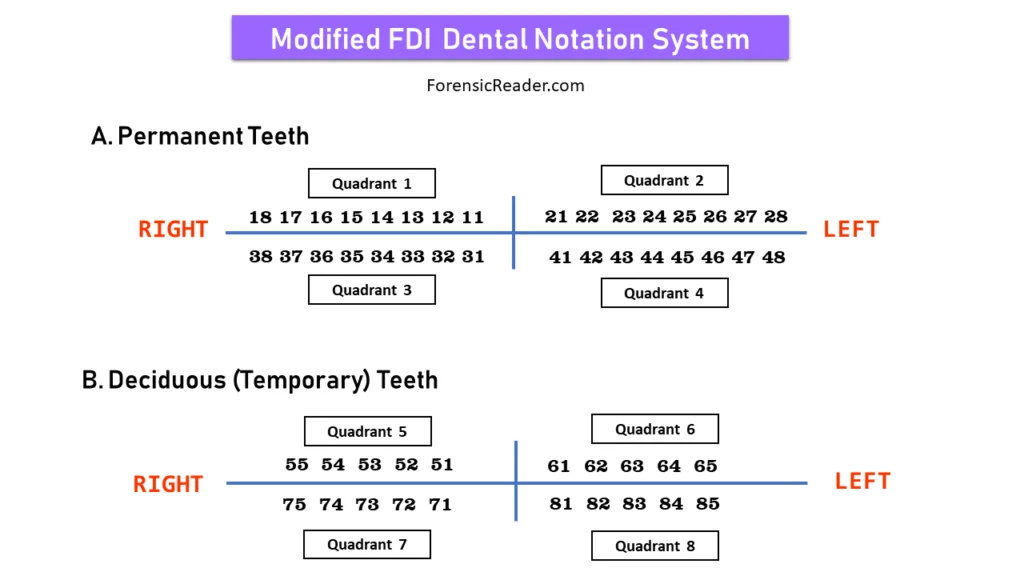
In modified FDI notation, the values in lower quadrants start with a new line. This means the lower quadrant for the lower right jaw will be #3 (in FDI it is #4).
Representation of Modified FDI Notation System for Permanent Teeth
- Upper Right (Quadrant 1): 18 17 16 15 14 13 12 11
- Upper Left (Quadrant 2): 21 22 23 24 25 26 27 28
- Lower Right (Quadrant 3): 38 37 36 35 34 33 32 31
- Lower Left (Quadrant 4): 41 42 43 44 45 46 47 48
Representation of Modified FDI Notation System for Deciduous Teeth
- Upper Right (Quadrant 5): 55 54 53 52 51
- Upper Left (Quadrant 6): 61 62 63 64 65
- Lower Right (Quadrant 7): 75 74 73 72 71
- Lower Left (Quadrant 8): 81 82 83 84 85
7. Haderup Tooth Numbering System
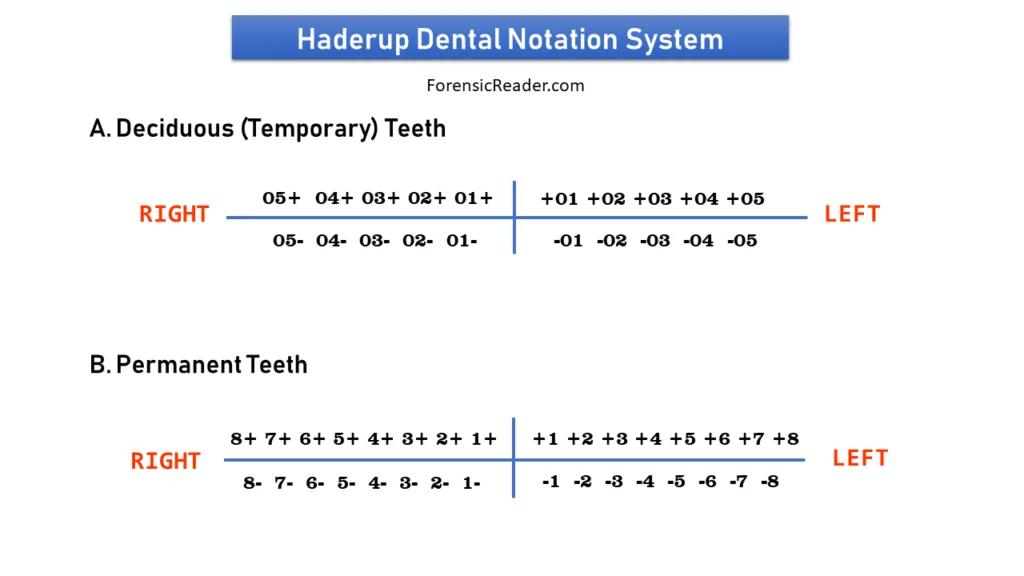
A common dental notation system for Scandinavian countries such as Denmark, Norway, and Sweden. It was developed in 1902.
Here, values of upper jaw teeth are designated by ‘+’ sign (‘-‘ for lower teeth) which is assigned left (for left sides teeth) or right (for right side teeth) followed by numbered values from 1 to 8 for permanent teeth.
Representation of Haderup Notation System for Deciduous Teeth
- Upper Right Quadrant: 05+ 04+ 03+ 02+ 01+
- Upper Left Quadrant: +01 +02 +03 +04 +05
- Lower Right Quadrant: 05- 04- 03- 02- 01-
- Lower Left Quadrant: -01 -02 -03 -04 -05
Representation of Haderup Notation System for Permanent Teeth
- Upper Right Quadrant: 8+ 7+ 6+ 5+ 4+ 3+ 2+ 1+
- Upper Left Quadrant: +1 +2 +3 +4 +5 +6 +7 +8
- Lower Right Quadrant: 8- 7- 6- 5- 4- 3- 2- 1-
- Lower Left Quadrant: -1 -2 -3 -4 -5 -6 -7 -8
References:
- Essentials of Forensic Medicine and Toxicology by Anil Aggarwal
- Manual of Forensic Odontology by David R. Senn [Book].
Read More:
- Age Estimation From Teeth: All Forensic Odontology Tables Included
- Forensic Casting Materials: How to Choose One For Different Surfaces?
- Forensic Rulers and Scales: Types, Characteristics, and Uses
- 47 Branches Of Forensic Science: Disciplines And Division With Evidence And Case Types

FR Author Group at ForensicReader is a team of Forensic experts and scholars having B.Sc, M.Sc, or Doctorate( Ph.D.) degrees in Forensic Science. We published on topics on fingerprints, questioned documents, forensic medicine, toxicology, physical evidence, and related case studies. Know More.

Pingback: Age Estimation From Teeth: All Forensic Odontology Tables Included